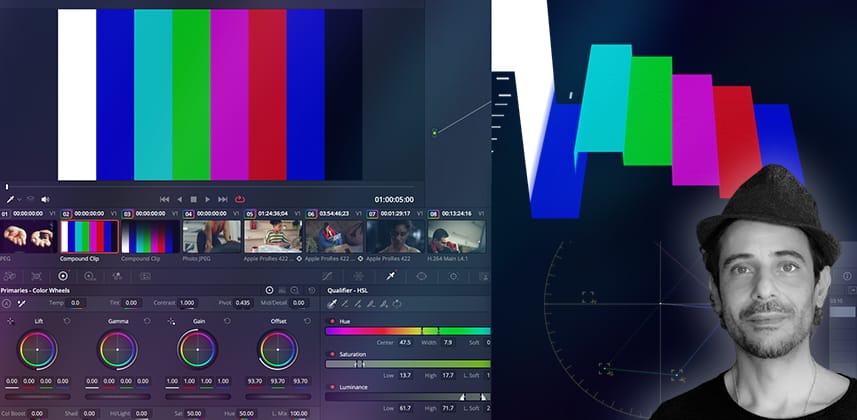Exploring node-based color micro-management in the HSL color model
In a perfect world, video files, DaVinci Resolve (and related tools), as well as our hardware (monitors and screens) all share the same color model – say, some RGB variant. From capture to final output, in this perfect world we’d never require mathematical transformations “under the hood” as our images are moved and manipulated.
But the real world isn’t perfect. Our video files are encoded in the Y’CbCr color model. Our monitors output in the RGB color space. And DaVinci Resolve, the middleman, works in YRGB – a ‘best of both worlds compromise.
However, Resolve’s compromise isn’t perfect, and some of Resolve’s tools are designed around the HSL color model. In the transform between (Y)RGB and HSL color models – stuff happens. What kind of stuff? All sorts… some negligible, others just taken for granted, but once in a while, there are corners where our images pay the price – such as hue adjustments.
Manipulating Hues more effectively
A student recently asked me why some hues don’t easily transition to others. Every colorist runs into this issue once in a while when trying to change from one color to another. So… Green becomes blue, and blue becomes red rather nicely – but try changing a nice bright blue or red to yellow or cyan, and you’ll get disappointing results.
Then, you find yourself doing more work to get what you intended – but often exposing artifacts.
This Insight is the product of my answer to the student about ‘why’ this is so? I think it’s worth bringing this discussion out of a single classroom and onto Mixing Light. I hope you find this as interesting as I did and maybe even use it in an upcoming project.
Key takeaways from this Insight
By the end of this Insight, you should understand:
- What is the HSL color model, and how does it differ from RGB?
- Why manipulating hue with some DaVinci Resolve tools feels limited in its results (and why it’s not Resolve’s fault)
- How to color-(micro)manage a node to operate in H-only and the potential benefits
- How to expand this technique to manipulating Sat and Lum as well
- That your waveform trace can be (sort of) seen from its side
Additional considerations
HSL has some limitations that can produce results that don’t perfectly match expectations. The technique in this Insight can (and should) be explored using similar color models. There are HSL/HSV alternatives that overcome some drawbacks but need to be migrated into Resolve via DCTLs or other plugins.
External Links
- Pond5: Free Stock Footage – The images in this Insight were gathered from Pond5’s free image gallery.
- Color Model vs Color Space: A Beginner’s Guide – A blog post explaining the technical differences between a ‘color model’ and a ‘color space’ and when to use each term.
Related Mixing Light Insights
- Cullen Kelly’s Visual Math series – Cullen covers different aspects of this topic in his Visual Math series.
Questions or Comments? Leave a comment!
Is this Insight useful to you? Let us know! Mixing Light is all about community discussions and we’re curious if you found this helpful, if you have something to add, or if you need more questions answered?
– Hector
Member Content
Sorry... the rest of this content is for members only. You'll need to login or Join Now to continue (we hope you do!).
Need more information about our memberships? Click to learn more.
Membership optionsMember Login
Additional Downloads
Sorry... downloads are available for Premium Members only.
Become a Premium Member

